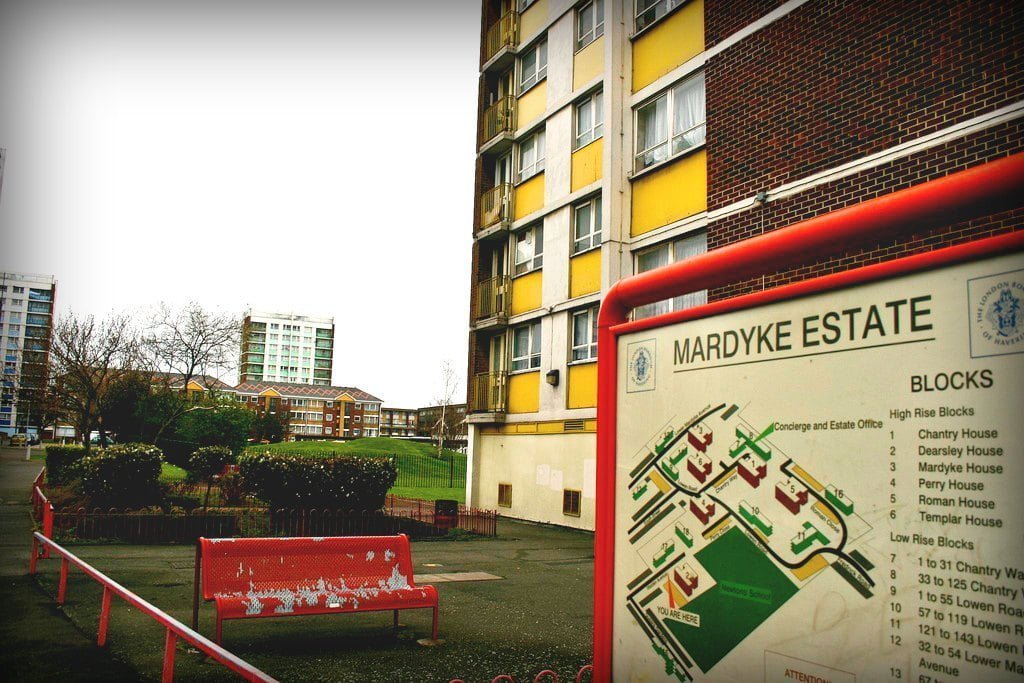The last decade has seen a sharp rise in profiteering from the building and maintenance of social housing. Although most building projects have concentrated on the upper-end of the market, there has also been some public funding made available for working-class accommodation – a source of easy profits for the private firms involved.
The last decade has seen a sharp rise in profiteering from the building and maintenance of social housing. Although most building projects have, certainly in London anyway, concentrated on the upper-end of the market with flats and housing for the well-off, there has also been some public funding made available for working-class accommodation. Not nearly enough, of course, to solve the housing crisis – but certainly a nice source of easy profits for the private firms involved.
How does this all work? The Guardian, on 7th February, published a report headed ‘Leaking sewage and rotten floorboards: life on a “flagship” housing estate’.The article refers to what was formerly known as the Mardyke estate in the outer-east London borough of Havering, on the Essex border and near to the now-largely gone Ford works at Dagenham. Mardyke was one of many faceless high-rise estates built after the war. Initially deemed quite attractive compared to the east-end slums where many of the residents had lived previously, it soon showed signs of decay as poverty and disrepair made their mark. At times it looked like the estate had been twinned with a war zone – The Guardian described the estate as being ‘notorious’. In 2009, the process of knocking down the whole estate begun with the aim of building a completely new one fit for people to live in.
This huge project was put in the hands of something called the Circle Housing Group – an organisation that has pocketed nearly £250 million pounds in public money in the period up to 2016 in order to build and maintain housing stock, primarily old council house estates. They were given £12.5 million by the Homes and Community Agency for the Mardyke rebuild, and a further £18.8 million came from the Greater London Authority.
Orchard Village
So how did they spend the money? Pretty cheaply it seems. When the estate re-opened they decided on a sudden rebrand – the 365 bus was no longer going to Rainham Mardyke, but to a nice-sounding place called Orchard Village. People had high hopes, but soon discovered the truth. The Guardian report presented the case of one new resident, Colin Nickless, who had been initially keen to move to the estate:
“‘We realised pretty quickly that there were loads of problems with our house,’ says Colin. He goes on to recount some of the many faults and failings that quickly revealed themselves – and, he discovered, were being experienced by people all over the estate: problems with draughts and leaks, an erratic heating system, mould growing on walls, and an absence of insulation in the walls and ceilings, so bad that in wet weather, his daughter’s bedroom is filled with the cacophonous sound of raindrops hitting the roof. He puts the number of repairs to the house so far at 117.”
One resident had her stairs collapse only to discover that they had been held up with two pieces of plastic. It was also noted that there seemed to be ‘high local levels of methane and hydrogen sulphide, which they say are partly caused by the estate’s proximity to a landfill site.’
Concerns about the standards of construction on the estate have been compounded by the lack of urgency, to put it politely, being shown by Circle towards carrying out repairs and dealing with the mounting problems.
The Guardian report adds to this:
Residents have a dossier of problems drawn from more than 50 homes: “holes in roof of landings”, “mould in bedroom”, “balcony door broken”, “cold house”, “lawn dying after no drainage installed”, “no fire break in between properties”. Some annual heating and hot water bills are said to be three times more than people were led to expect. There are also endless claims about treatment of residents by Circle and its contractors: “Waited three years for repair of stairs”; “staff ignore telephone conversations”; “no response to complaints”.
On opening, the Orchard Village estate was described by the Tories as being a “model” of the way to go over housing. Model profits it seems. Circle has now been subsumed into the Clarion Housing Group, one of the “mega-associations” now dominating the market. Clarion, we are told, stand to get a massive £1.1 billion pounds in public money over the next period to buy up huge amounts of land with a view to building more housing. Judging by the cost-cutting standards seen with the Orchard Village, it looks like some people are going to do very well out of this at our expense.
Surely, you may ask, somebody should have been checking up on this to ensure that correct standards were maintained? The main body responsible, the Homes and Community Agency, has been accused of inaction. It downgraded Circle’s standards rating on the basis of complaints about work in Havering and Tower Hamlets, only to up it again without reason. The suspicion, reported in The Guardian, is that some at the Agency were more than keen to protect Circle, as it was politically advantageous in view of future projects. Questions should also be asked about the local council. Havering has been run for the last decade by a group of rather smug, if not quite shady, bunch of Tories. This “business friendly” administration has cut services to the bone and has been pretty silent about the emerging scandal of the Orchard Village.
Housing for the millions, not the millionaires
This is the reality of how our council estates are being run today. The quality stock built in the years before the war is still standing and in good shape, whereas the recent cheap-but-not-so-cheerful stuff is falling apart. It has even been suggested that the whole Orchard Village estate should now be knocked down and rebuilt from scratch. Developers are building good quality stock for the well-off (and turfing out the former tenants to boot), whereas the so-called social housing stock is being done on the cheap to maximise profits for the construction firms and the mega-housing associations that have replaced the old council housing departments.
The demand should now be to get rid of these profiteers, take all council housing back under public control and ownership, and begin a serious programme of council house building to solve the real housing crisis which now afflicts our towns and cities.
Labour should commit itself to ending the cosy relationship with these cowboys and take the construction industry into public ownership for the benefit of society. Rather than build housing for the rich, decent affordable housing for workers should be built. Empty stock should be taken over and made available for working class people who are looking for a place to live. Rents should be fixed at levels that workers can afford to pay. This is what a socialist programme for housing should be: homes for the millions, not the millionaires.
Picture by Nico Hogg, Flickr, CC-by-2.0






